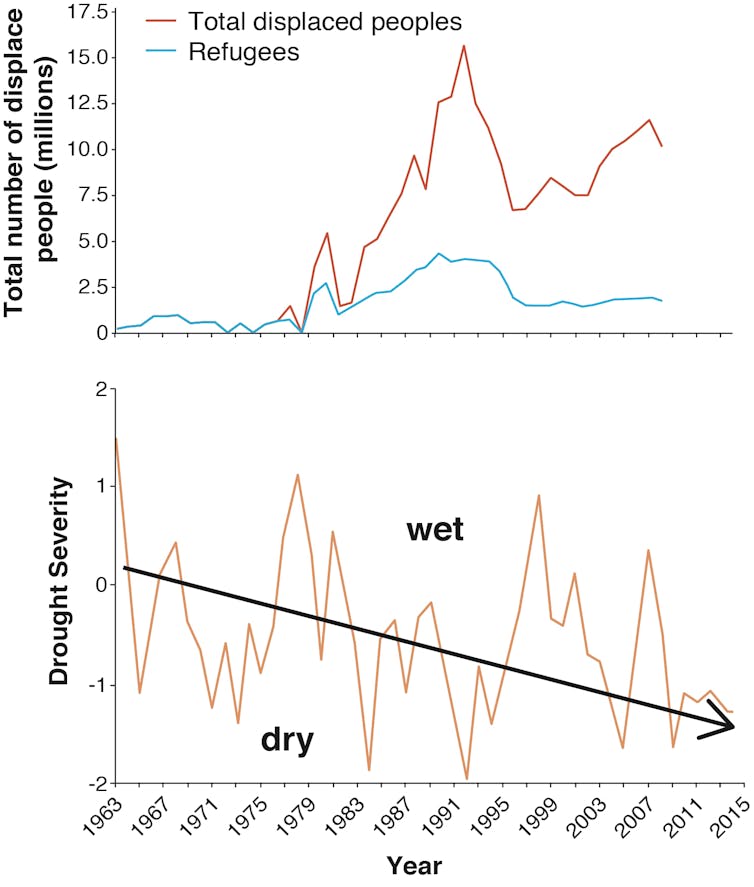“The Darfur conflict began as an ecological crisis”, wrote the then UN secretary general Ban Ki-Moon back in 2007, about an ongoing war which arose, he said, “at least in part from climate change”. Since then the idea that climate change has caused and will cause human conflict and mass migrations has become more and more accepted – just look at the claimed effects of droughts in Syria and Ethiopia.
The media has even started using terms such as “climate refugees” and “environmental migrants” to describe people fleeing their homes from these climate-driven conflicts. But it isn’t clear whether there is much evidence for this link between climate change and conflict – there certainly seems to be no consensus within the academic literature.
In our recent paper, my student Erin Owain and I decided to test the climate-conflict hypothesis, using East Africa as our focus. The region is already very hot and very poor, making it especially vulnerable to climate change (in fact neighbouring Chad is by some measures the single most vulnerable country in the world).
As the planet warms, East Africa’s seasonal rains are expected to become much more unpredictable. This is a particular problem as recent economic development has been concentrated in agriculture, a highly climate-sensitive sector that accounts for more than half of the entire economy in countries like Ethiopia or Sudan. One study led by the European Commission found that declining rainfall over the past century may have reduced GDP across Africa by 15-40 per cent compared with the rest of the developing world.
East Africa also has a long history of conflict and human displacement, which persists in some countries to this day, such as the civil wars in Sudan and Somalia. The UN Refugee Agency reports there were more than 20m displaced people in Africa in 2016 – a third of the world’s total. The World Bank predicts this could rise up to 86m by 2050 due to climate change.
Is it really because of climate change?
To test the climate-conflict hypothesis, Erin and I therefore focused on the ten main countries in East Africa. We used a new database that records major episodes of political violence and number of total displaced people for the past 50 years for each of the ten countries. We then statistically compared these records both at a country and a regional level with the appropriate climatic, economic and political indicators.
We found that climate variations such as regional drought and global temperature did not significantly impact the level of regional conflict or the number of total displaced people. The major driving forces on conflict were rapid population growth, reduced or negative economic growth and instability of political regimes. Numbers of total displaced people were linked to rapid population growth and low or stagnating economic growth.
The evidence from East Africa is that no single factor can fully explain conflict and the displacement of people. Instead, conflict seems to be linked primarily to long-term population growth, short-term economic recessions and extreme political instability. Halvard Buhaug, a professor at the Peace Research Institute Oslo, looked at the same questions in 2015 and his study reached much the same conclusion: sociopolitical factors were more important than climate change.

Lower levels of conflict are associated with economic growth and stable politics. Owain and Maslin, 2018, Author provided
But refugees are linked to climate change
Things were different for refugees, however – those displaced people who were forced to cross borders between countries. Refugee numbers were related to the usual demographic and socio-economic factors. But in contrast to total displaced people and occurrence of conflict, variations in refugee numbers were found to be related significantly to the incidence of severe regional droughts. And these droughts can in turn be linked to a long-term drying trend ascribed to anthropogenic climate change.

As droughts have become more severe, refugee numbers have increased. Owain and Maslin, 2018, Author provided
However, it is important to consider the counterfactual: had there been slower population growth, stronger economies and more stable political regimes, would these droughts still have led to more refugees? That’s beyond the scope of our study, which may not be a definitive test of the links between climate change and conflict. But the occurrence of peaks in both conflict and displaced people in the 1980s and 1990s across East Africa suggest that decolonisation and the end of the Cold War could have been key issues.
Nonetheless, while conflict has decreased across the region since the end of the Cold War, the number of displaced people remains high. We argue that with good stable governance there is no reason why climate change should lead to greater conflict or displacement of people, despite the World Bank’s dire predictions. Water provides one reason to be optimistic. The UN reports that, over the past 50 years, there have been 150 international water resource treaties signed compared to 37 disputes that involved violence.
What our study suggests is the failure of political systems is the primary cause of conflict and displacement of large numbers of people. We also demonstrate that within socially and geopolitically fragile systems, climate change may potentially exacerbate the situation particularly with regards to enforced migration.
This article was originally published on The Conversation. Read the original article.


